Community Forum
Horse World Online
Breed horses and ponies, raise your foals, and train the next champion in this exciting and realistic online horse breeding game.
The new layout is in beta testing and we're inviting you to help us try it out! Click here to read the announcement post for details.
Guide: How to identify my horse's colour
Forum rules
You can link to a horse using our new custom BBCode:
[horse=1234]Horses Name[/horse]
This will display the most recent photo of the horse as well as a link to him.
You can link to a horse using our new custom BBCode:
[horse=1234]Horses Name[/horse]
This will display the most recent photo of the horse as well as a link to him.
8 posts
• Page 1 of 1
-
Djeraya
- Posts: 155
- Joined: Tue Feb 16, 2016 6:01 pm
- Visit My Farm
Guide: How to identify my horse's colour
Post by Djeraya »
There is really nice guides at the top of this section (this one is really helpful: click), however they are not fully complete and apparently still confusing for newbies.
Hence I thought about a "basic" guide about how to identify your horse's colour. The goal is to help you to know what traits you are looking for.
Helpful Hints:
Sometimes the colour is really hard to identify, even for experts. What can help is looking onto older foal pictures and parents. Checking if you have an adoption centre horse/what breed can also be helpful because not all colours exist in all breeds.
Base colours:
The base colours are called bay, chestnut, black and brown. All other colour genes like cream, flaxen, dun, etc etc are modifiers. So each weirdly coloured horse like so called cremello, buckskin, gold cream has one of those 4 base colours plus some other genes to modify their appearence.
Let's check first on how to identify horses without modifiers. This will help you later on the identification of more complicated horses.
Black:
This one is easy. The horse is pure black, not dark brown or something, just black.
However with modifications the horses can look grey/silver or chocolate brown. What you can remember is, the whole body, mane, tail usually have the same colour though. Exceptions would be silver (light mane, rest brown, often with spots) and dun (body grey, black mane).
Foals are not black yet either, but chocolate brown.
Black Arabian
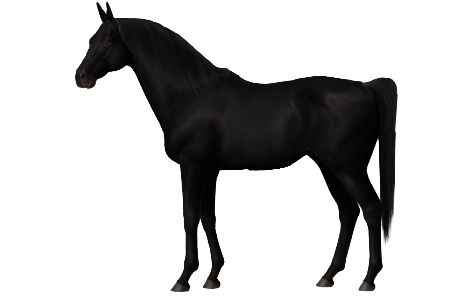
You can also look on her foal picture.
Chestnut:
A chestnut without modifiers looks red, like a fox.
What you can remember is, a chestnut's mane, tail, feathers and legs have the same or lighter colour as their base coat. If that's not the case, it's not a chestnut. This is usually also true for modified horses. Exceptions can happen if horses are going grey or dun. A chestnut usually doesn't have any black hair. However there can be really really dark chestnuts (not black), and varnish/sooty can sometimes make quite some dark patches.
Nice red Chestnut
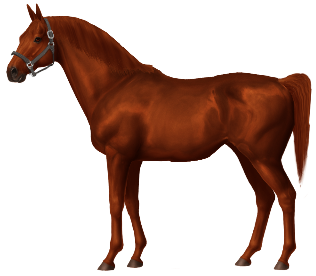
Nearly orange chestnut.
Dark/sooty Chestnut with Flaxen
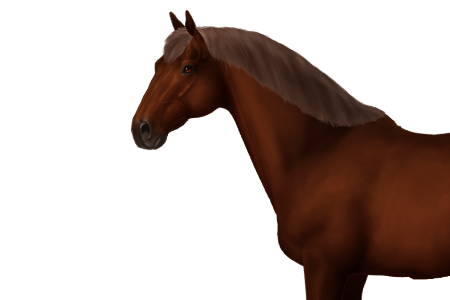
Tricky one, right? Check how she has light parts on the legs and mane and how her foal/oder picture has a light mane. Her basecoat still looks pretty red though.
Sooty Dun Chestnut (Red Dun)
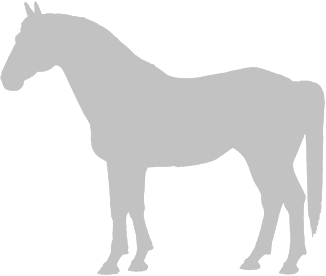
Note how his legs and mane are darker than the base but still red and not black. Also see his younger picture how bright red he was.
Bay:
Contrary to a chestnut, a bay horse usually has darker legs, mane and tail than his base colour. The base colour also is less red, more brown. Without modifiers mane, tail and legs are even black. A few modifiers can lighten the mane so it can get a bit confusing, however the legs are usually still darker than the rest of the body. Foals don't show darker legs immediately after birth but after a few weeks.
Normal bay

Look how her foal picture has only slightly darker mane/legs but with half a year already has clearly darker legs.
Silver Bay Dun
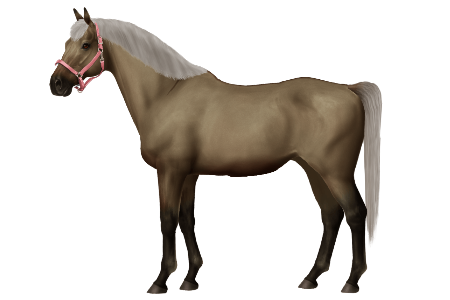
This horse has silver modifying its mane and tail, however his legs are still dark!
Brown:
Genetically brown is related to bay. While mane/tail are black on unmodified brown horses, the legs are dark but the contrast is not as high as on bay horses, the legs are rather coloured like the rest of the body, a dark brown colour, with slighty red or yellowish belly and mouth. This lighter/red mouth and belly are what helps you distinguish this base colours from others. The foal colour looks quite similar to bay.
Brown
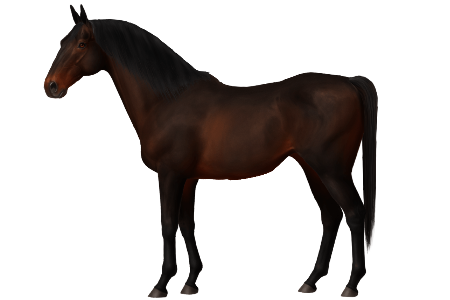
Dark brown
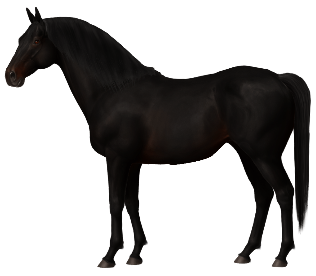
She is very dark, however not black, and you can see red at her mouth and belly.
Silver brown
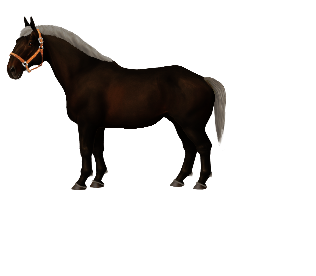
He has silver modifying mane, tail and feathers, however he has red brown at mouth and belly.
Hence I thought about a "basic" guide about how to identify your horse's colour. The goal is to help you to know what traits you are looking for.
Helpful Hints:
Sometimes the colour is really hard to identify, even for experts. What can help is looking onto older foal pictures and parents. Checking if you have an adoption centre horse/what breed can also be helpful because not all colours exist in all breeds.
Base colours:
The base colours are called bay, chestnut, black and brown. All other colour genes like cream, flaxen, dun, etc etc are modifiers. So each weirdly coloured horse like so called cremello, buckskin, gold cream has one of those 4 base colours plus some other genes to modify their appearence.
Let's check first on how to identify horses without modifiers. This will help you later on the identification of more complicated horses.
Black:
This one is easy. The horse is pure black, not dark brown or something, just black.
However with modifications the horses can look grey/silver or chocolate brown. What you can remember is, the whole body, mane, tail usually have the same colour though. Exceptions would be silver (light mane, rest brown, often with spots) and dun (body grey, black mane).
Foals are not black yet either, but chocolate brown.
Black Arabian

You can also look on her foal picture.
Chestnut:
A chestnut without modifiers looks red, like a fox.
What you can remember is, a chestnut's mane, tail, feathers and legs have the same or lighter colour as their base coat. If that's not the case, it's not a chestnut. This is usually also true for modified horses. Exceptions can happen if horses are going grey or dun. A chestnut usually doesn't have any black hair. However there can be really really dark chestnuts (not black), and varnish/sooty can sometimes make quite some dark patches.
Nice red Chestnut

Nearly orange chestnut.
Dark/sooty Chestnut with Flaxen

Tricky one, right? Check how she has light parts on the legs and mane and how her foal/oder picture has a light mane. Her basecoat still looks pretty red though.
Sooty Dun Chestnut (Red Dun)

Note how his legs and mane are darker than the base but still red and not black. Also see his younger picture how bright red he was.
Bay:
Contrary to a chestnut, a bay horse usually has darker legs, mane and tail than his base colour. The base colour also is less red, more brown. Without modifiers mane, tail and legs are even black. A few modifiers can lighten the mane so it can get a bit confusing, however the legs are usually still darker than the rest of the body. Foals don't show darker legs immediately after birth but after a few weeks.
Normal bay

Look how her foal picture has only slightly darker mane/legs but with half a year already has clearly darker legs.
Silver Bay Dun

This horse has silver modifying its mane and tail, however his legs are still dark!
Brown:
Genetically brown is related to bay. While mane/tail are black on unmodified brown horses, the legs are dark but the contrast is not as high as on bay horses, the legs are rather coloured like the rest of the body, a dark brown colour, with slighty red or yellowish belly and mouth. This lighter/red mouth and belly are what helps you distinguish this base colours from others. The foal colour looks quite similar to bay.
Brown

Dark brown

She is very dark, however not black, and you can see red at her mouth and belly.
Silver brown

He has silver modifying mane, tail and feathers, however he has red brown at mouth and belly.
Last edited by Djeraya on Wed Sep 14, 2016 2:00 pm, edited 3 times in total.
-
Djeraya
- Posts: 155
- Joined: Tue Feb 16, 2016 6:01 pm
- Visit My Farm
Re: Basic Guide: How to identify my horse's colour
Post by Djeraya »
Modifiers:
Now, you met 4 base colours, what modifiers are there?
Flaxen and silver only modify mane, tail and feathers. (exception silver on black)
Grey makes the whole horse go white when it ages. (mane is sometimes not greying)
Dun makes a so called primitive look.
Pangare makes belly and mouth lighter. Is rarely considered, because it doesn't change the appearance a lot.
Sooty makes the whole horse darker or just parts of the horse.
Roan makes the middle of the body covered in grey hair. Head, legs, mane and tail will stay their usual colour.
Metallic makes a metallic shine, different than that of a trained horse. Rarely considered.
Cream and Pearl generally make the horse lighter and more creamy.
Champagne makes the horse lighter and freckles on its mouth.
Leopard complex can make spots, white areas (blanket) and varnish. Varnish lets the horse go greyish/lighter and sometimes also darker with time. It can also blur black to reddish (bronzing).
Remember, each horse still has its base colour chestnut, brown, black or bay plus potentially modifiers.
Flaxen and Silver:
Both genes make the mane, tail and feathers lighter. However flaxen is only visible on chestnut horses and silver only visible on bay, black and brown. The inheritance is also different. Flaxen can hide without showing on a chestnut, silver when present on bay, black, brown is always visible.
Silver on black base not only modifies the mane, tail and feathers but also makes the whole body lighter, a brown or grey tone, frequently with dapples. These dapples are not the same as Leopard spots.
Silver Bay
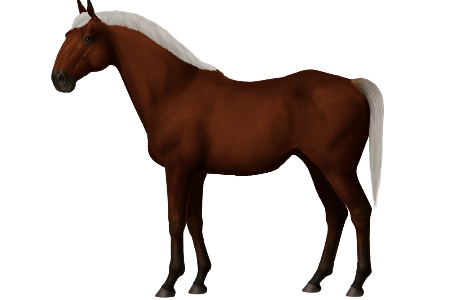
Look how he has silver mane but still black/dark legs and regular bay body. He has no feathers, which would be silver too.
Silver black

A black based horse with silver. Silver mane, tail and feathers, the coat brownish with slight spots.
Flaxen Chestnut
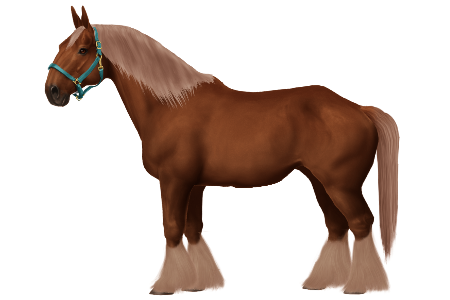
Grey:
It's called grey, but actually makes the horse go white when it ages. Foals are born in their base colour but the colour is more intense. For example bay foals usually don't have black legs, but if carrying grey, they have. Greying takes a looong time and appears differently on different horses. The first thing to go grey is the area round the eyes. Mane sometimes stays and doesn't go grey. The body can have so called fleabitten spots.
Grey on flaxen chestnut
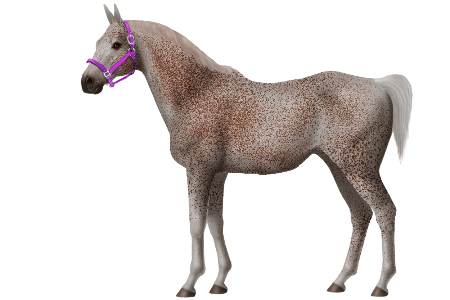
Look how this mare's colour changed when she aged, starting with a grey area around her eyes.
Dun:
creates a primitive look. It can be recognised by a dorsal stripe, zebra markings on the legs and neck, generally slightly darker legs and a mask on the head, sometimes also the belly looks different. The base coat also is lightened a bit. However all those markings can be hard to see, especially on light/creamy horses.
Bay Dun
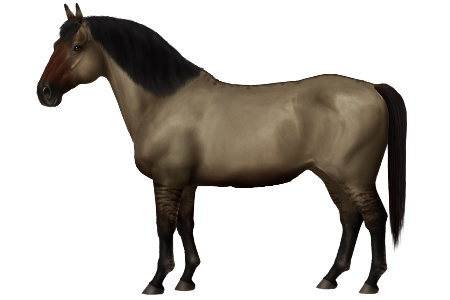
Clear zebra legs, mask on head, marks on the back.
Bay Dun, w. slight Pangare

Quite hard to see. However she has a slight mask and slighty darker legs above the black area. A slightly lighter coat and the dorsal stripe can be seen on some older pictures. I believe her daughter (Drama) inherited it, but it's even harder to see.
Pangare:
is only present in some breeds, so it's not frequent and sometimes not good to see. Hence, it is not mentioned often. Makes an area around the mouth and the belly lighter. Also called "mealy". Pangare doesn't show up on black.
Mealy flaxen chestnut
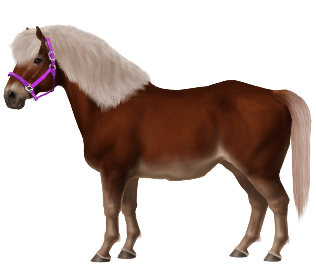
Bay with slight pangare
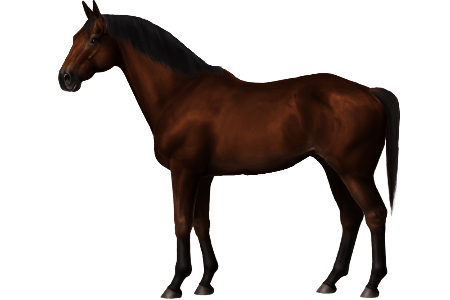
Sooty:
makes the whole horse darker or just parts of the horse. Sooty can darken the horse so much that light colours can be confused with others. Very rarely sooty horses have dapples. The dapple gene is seperate and can be carried hidden on non-sooty horses.
Metallic sooty chestnut with dapples and pangare
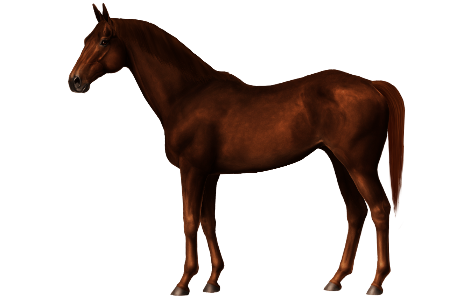
Very dark chestnut
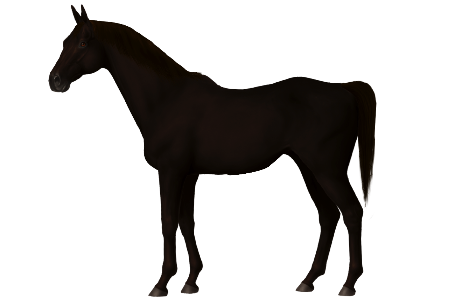
Roan:
makes the middle of the body covered in grey/white hair. Head, legs, mane and tail will stay their usual colour. Can be a bit hard to see, especially on light horses.
Roan on a black horse, also called Blue Roan
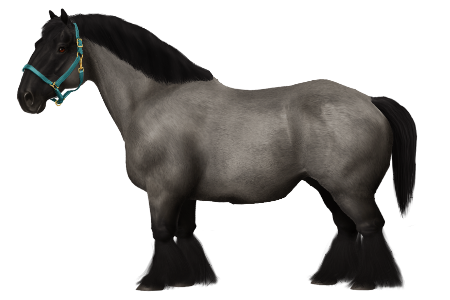
Bay Dun Roan
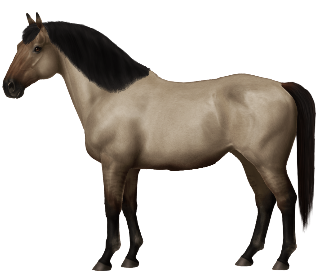
Now, you met 4 base colours, what modifiers are there?
Flaxen and silver only modify mane, tail and feathers. (exception silver on black)
Grey makes the whole horse go white when it ages. (mane is sometimes not greying)
Dun makes a so called primitive look.
Pangare makes belly and mouth lighter. Is rarely considered, because it doesn't change the appearance a lot.
Sooty makes the whole horse darker or just parts of the horse.
Roan makes the middle of the body covered in grey hair. Head, legs, mane and tail will stay their usual colour.
Metallic makes a metallic shine, different than that of a trained horse. Rarely considered.
Cream and Pearl generally make the horse lighter and more creamy.
Champagne makes the horse lighter and freckles on its mouth.
Leopard complex can make spots, white areas (blanket) and varnish. Varnish lets the horse go greyish/lighter and sometimes also darker with time. It can also blur black to reddish (bronzing).
Remember, each horse still has its base colour chestnut, brown, black or bay plus potentially modifiers.
Flaxen and Silver:
Both genes make the mane, tail and feathers lighter. However flaxen is only visible on chestnut horses and silver only visible on bay, black and brown. The inheritance is also different. Flaxen can hide without showing on a chestnut, silver when present on bay, black, brown is always visible.
Silver on black base not only modifies the mane, tail and feathers but also makes the whole body lighter, a brown or grey tone, frequently with dapples. These dapples are not the same as Leopard spots.
Silver Bay

Look how he has silver mane but still black/dark legs and regular bay body. He has no feathers, which would be silver too.
Silver black

A black based horse with silver. Silver mane, tail and feathers, the coat brownish with slight spots.
Flaxen Chestnut

Grey:
It's called grey, but actually makes the horse go white when it ages. Foals are born in their base colour but the colour is more intense. For example bay foals usually don't have black legs, but if carrying grey, they have. Greying takes a looong time and appears differently on different horses. The first thing to go grey is the area round the eyes. Mane sometimes stays and doesn't go grey. The body can have so called fleabitten spots.
Grey on flaxen chestnut

Look how this mare's colour changed when she aged, starting with a grey area around her eyes.
Dun:
creates a primitive look. It can be recognised by a dorsal stripe, zebra markings on the legs and neck, generally slightly darker legs and a mask on the head, sometimes also the belly looks different. The base coat also is lightened a bit. However all those markings can be hard to see, especially on light/creamy horses.
Bay Dun

Clear zebra legs, mask on head, marks on the back.
Bay Dun, w. slight Pangare

Quite hard to see. However she has a slight mask and slighty darker legs above the black area. A slightly lighter coat and the dorsal stripe can be seen on some older pictures. I believe her daughter (Drama) inherited it, but it's even harder to see.
Pangare:
is only present in some breeds, so it's not frequent and sometimes not good to see. Hence, it is not mentioned often. Makes an area around the mouth and the belly lighter. Also called "mealy". Pangare doesn't show up on black.
Mealy flaxen chestnut

Bay with slight pangare

Sooty:
makes the whole horse darker or just parts of the horse. Sooty can darken the horse so much that light colours can be confused with others. Very rarely sooty horses have dapples. The dapple gene is seperate and can be carried hidden on non-sooty horses.
Metallic sooty chestnut with dapples and pangare

Very dark chestnut

Roan:
makes the middle of the body covered in grey/white hair. Head, legs, mane and tail will stay their usual colour. Can be a bit hard to see, especially on light horses.
Roan on a black horse, also called Blue Roan

Bay Dun Roan

Last edited by Djeraya on Wed Sep 14, 2016 12:09 pm, edited 4 times in total.
-
Djeraya
- Posts: 155
- Joined: Tue Feb 16, 2016 6:01 pm
- Visit My Farm
Re: Basic Guide: How to identify my horse's colour
Post by Djeraya »
Cream:
Cream makes the whole horse brighter and creamy. You can say that Cream has two stages. A horse can have 1 cream gene or 2 (or 0). For some colours/modifiers it doesn't make a difference on the visual appearance of the horse if it has 1 or 2 copies of the gene, for example silver or dun, however Cream looks different with 0, 1 or 2 copies. Only black horses with 1 cream gene look the same as with 0, however their foal colours are different.
Remember what you read about distinguishing the base colours and that every coloured horse has a base colour? This still applies for Cream horses.
This is how the colours are called with 0, 1 or 2 Cream genes and no other modifiers:
Bay -> Buckskin -> Perlino
Black -> Smoky Black -> Smoky Cream
Chestnut -> Palomino -> Cremello
Brown -> Smoky Brown -> Brown Cream
For the specific colours look onto this guide.
Let's just look on a few examples:
Smoky Black
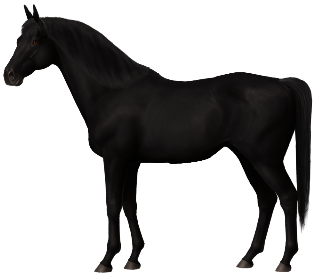
This horse looks black, but it has 1 cream gene which can be inherited. The foal colour is not chocolate like for a normal black horse but grey.
Buckskin Dun
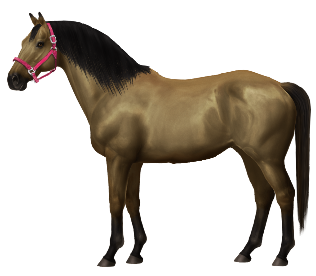
A bay horse with 1 cream and dun (and a bit sooty). Mane, tail and legs are black. Dun shows itself on the mouth and above the legs. Click here to compare with a metallic buckskin and here with a buckskin with silver.
Metallic Sooty Cremello
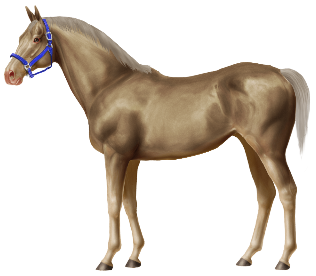
This is a chestnut based mare with 2 copies of cream and sooty. Look on the older pictures to see that she was light creamy, mane and legs lighter than her base coat. A bay based horse would have darker legs.
A dark sooty Perlino
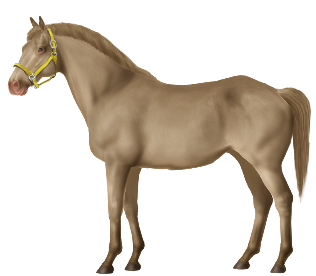
Check his foal colour, where he is a bit lighter.
Pearl:
A very rare colour, in the adoption centre only to be found in North African Barbs. Pearl is related to Cream, it is a variant of Cream. It creates similar colours to cream and also interacts with it. A single pearl gene is not visible on a horse, that's the second reason why its rare to find pearl horses. Only two pearl genes create a differently looking horse. However, a single pearl can be seen when paired with one cream gene. Because it is a variant, horses cannot have 2 pearl genes and 2 cream genes, only 2 overall maximum. Pearl is frequently confused with Champagne and others. It often helps to look onto parents if pearl is a possibility. Double Pearl horses have dark eyes, contrary to double cream horses.
For the specific colours you can look onto this guide.
A few interesting examples, not shown in above guide:
Silver Black Pearl
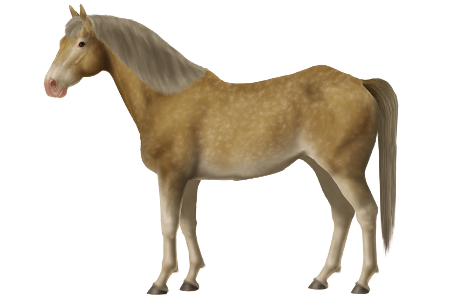
Black with double pearl and silver. Silver makes dapples and lighter coat on black. However it doesn't look like just normal silver black. A single pearl or cream on black would look the same as without. The horse can't have double cream, because its eyes are black.
Brown Pearl Dun
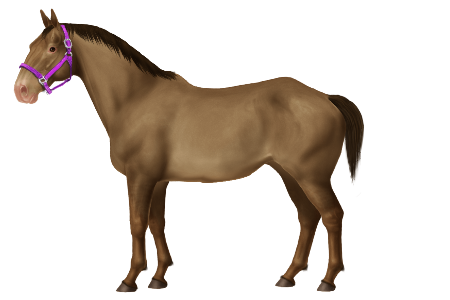
Brown with double pearl and dun, you can see the dun markings on the legs. Remember how to distinguish brown? This horse's mouth and belly are lighter then the rest of the body.
Pangare chestnut with hidden Pearl
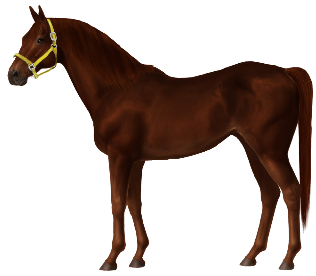
This stallion has 1 pearl gene, which doesn't change his appearence. However he can inherit it. How can I be so sure? He has a son, which is unusually light, a colour which can only be created by double cream or cream pearl, where 1 gene has to be from his dad, the pearl gene, because cream itself would be visible. Click here to see this palomino pearl boy (chestnut + 1 cream + 1 pearl).
Champagne
Champagne makes the horses brighter. It is sometimes overlooked if horses are already lighter through cream. However champagne horses have freckles on their mouth which are not too difficult to find. You might need to zoom in to see it.
Horses who have Champagne and Cream can be very bright and quite a bit confusing to identify.
Perlino Champagne
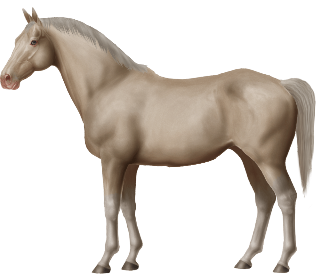
A horse with 2 Cream and Champagne on Bay Base. Usually legs and mane should be darker on a horse with a bay base, however with 2 cream and champagne they turn silvery (this horse doesn't carry the silver gene). What can be seen though, is that mane and legs have a different colour than the base, which wouldn't be the case for chestnut, brown or black based horses.
Gold Champagne Dun
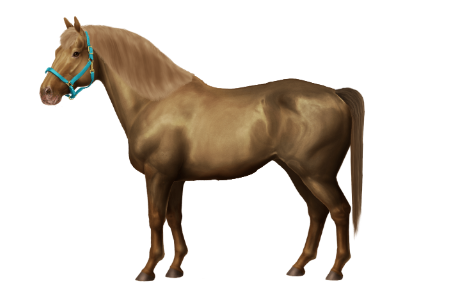
Chestnut based with Chapagne and Dun and a bit sooty on the back, very clear freckles.
Cream makes the whole horse brighter and creamy. You can say that Cream has two stages. A horse can have 1 cream gene or 2 (or 0). For some colours/modifiers it doesn't make a difference on the visual appearance of the horse if it has 1 or 2 copies of the gene, for example silver or dun, however Cream looks different with 0, 1 or 2 copies. Only black horses with 1 cream gene look the same as with 0, however their foal colours are different.
Remember what you read about distinguishing the base colours and that every coloured horse has a base colour? This still applies for Cream horses.
This is how the colours are called with 0, 1 or 2 Cream genes and no other modifiers:
Bay -> Buckskin -> Perlino
Black -> Smoky Black -> Smoky Cream
Chestnut -> Palomino -> Cremello
Brown -> Smoky Brown -> Brown Cream
For the specific colours look onto this guide.
Let's just look on a few examples:
Smoky Black

This horse looks black, but it has 1 cream gene which can be inherited. The foal colour is not chocolate like for a normal black horse but grey.
Buckskin Dun

A bay horse with 1 cream and dun (and a bit sooty). Mane, tail and legs are black. Dun shows itself on the mouth and above the legs. Click here to compare with a metallic buckskin and here with a buckskin with silver.
Metallic Sooty Cremello

This is a chestnut based mare with 2 copies of cream and sooty. Look on the older pictures to see that she was light creamy, mane and legs lighter than her base coat. A bay based horse would have darker legs.
A dark sooty Perlino

Check his foal colour, where he is a bit lighter.
Pearl:
A very rare colour, in the adoption centre only to be found in North African Barbs. Pearl is related to Cream, it is a variant of Cream. It creates similar colours to cream and also interacts with it. A single pearl gene is not visible on a horse, that's the second reason why its rare to find pearl horses. Only two pearl genes create a differently looking horse. However, a single pearl can be seen when paired with one cream gene. Because it is a variant, horses cannot have 2 pearl genes and 2 cream genes, only 2 overall maximum. Pearl is frequently confused with Champagne and others. It often helps to look onto parents if pearl is a possibility. Double Pearl horses have dark eyes, contrary to double cream horses.
For the specific colours you can look onto this guide.
A few interesting examples, not shown in above guide:
Silver Black Pearl

Black with double pearl and silver. Silver makes dapples and lighter coat on black. However it doesn't look like just normal silver black. A single pearl or cream on black would look the same as without. The horse can't have double cream, because its eyes are black.
Brown Pearl Dun

Brown with double pearl and dun, you can see the dun markings on the legs. Remember how to distinguish brown? This horse's mouth and belly are lighter then the rest of the body.
Pangare chestnut with hidden Pearl

This stallion has 1 pearl gene, which doesn't change his appearence. However he can inherit it. How can I be so sure? He has a son, which is unusually light, a colour which can only be created by double cream or cream pearl, where 1 gene has to be from his dad, the pearl gene, because cream itself would be visible. Click here to see this palomino pearl boy (chestnut + 1 cream + 1 pearl).
Champagne
Champagne makes the horses brighter. It is sometimes overlooked if horses are already lighter through cream. However champagne horses have freckles on their mouth which are not too difficult to find. You might need to zoom in to see it.
Horses who have Champagne and Cream can be very bright and quite a bit confusing to identify.
Perlino Champagne

A horse with 2 Cream and Champagne on Bay Base. Usually legs and mane should be darker on a horse with a bay base, however with 2 cream and champagne they turn silvery (this horse doesn't carry the silver gene). What can be seen though, is that mane and legs have a different colour than the base, which wouldn't be the case for chestnut, brown or black based horses.
Gold Champagne Dun

Chestnut based with Chapagne and Dun and a bit sooty on the back, very clear freckles.
Last edited by Djeraya on Wed Sep 14, 2016 1:39 pm, edited 3 times in total.
-
Djeraya
- Posts: 155
- Joined: Tue Feb 16, 2016 6:01 pm
- Visit My Farm
-
rarebreed
- Posts: 6
- Joined: Sun Dec 06, 2015 3:57 am
- Visit My Farm
Re: Guide: How to identify my horse's colour
Post by rarebreed »
What color are my horses? www.horseworldonline.net/horse/profile/457339 www.horseworldonline.net/horse/profile/506182
-
Cottens
- Posts: 22
- Joined: Fri Dec 13, 2019 6:35 pm
- Visit My Farm
Re: Guide: How to identify my horse's colour
Post by Cottens »
Up !
This guide is usefull to have a few example ! Since it drowned in the forum and isn't pinned to stay at the top, I will just take it back at the top for now Maybe it will drown again, maybe not
Maybe it will drown again, maybe not 
This guide is usefull to have a few example ! Since it drowned in the forum and isn't pinned to stay at the top, I will just take it back at the top for now
-
⫷CHC⫸
- Premium

- Posts: 7
- Joined: Fri Aug 26, 2022 12:01 am
- Visit My Farm
Re: Guide: How to identify my horse's colour
Post by ⫷CHC⫸ »
What would a black horse with red mane and tail ?? I have seen some and just curious to what it would be classified as?
-
EclipticEnd

- Posts: 1816
- Joined: Thu Dec 24, 2020 12:21 am
- Location: USA
- Visit My Farm
Re: Guide: How to identify my horse's colour
Post by EclipticEnd »
Probably a glitch, but it could also be a case of high expression sooty on a flaxen. I'd lean more toward a glitch, though; sometimes (most usually in the Adoption Center) there's horses that render oddly. They normally change into whatever color they're supposed to be after a few turns, but sometimes they swap pictures multiple times before settling. Their genetics remain as whatever they're supposed to be, though, so you can't use them to make some glitchy colors.⫷CHC⫸ wrote:What would a black horse with red mane and tail ?? I have seen some and just curious to what it would be classified as?
8 posts
• Page 1 of 1
Return to “What Colour Is My Horse?”
Jump to
- General Discussion
- ↳ Announcements
- ↳ Weekly Development Updates
- ↳ General Chit Chat
- ↳ Contests
- ↳ What Colour Is My Horse?
- ↳ Comments and Suggestions
- ↳ Suggestions Archive
- ↳ Breeding Communities
- ↳ Farm Logs
- Marketplace
- ↳ Horses for Sale
- ↳ Stallions at Stud
- Knowledgebase & Guides
- ↳ Gameplay Questions & Help
- ↳ Guides & How To
- Technical
- ↳ Change Log v3
- Guest Discussions
- ↳ Public Questions & Answers
